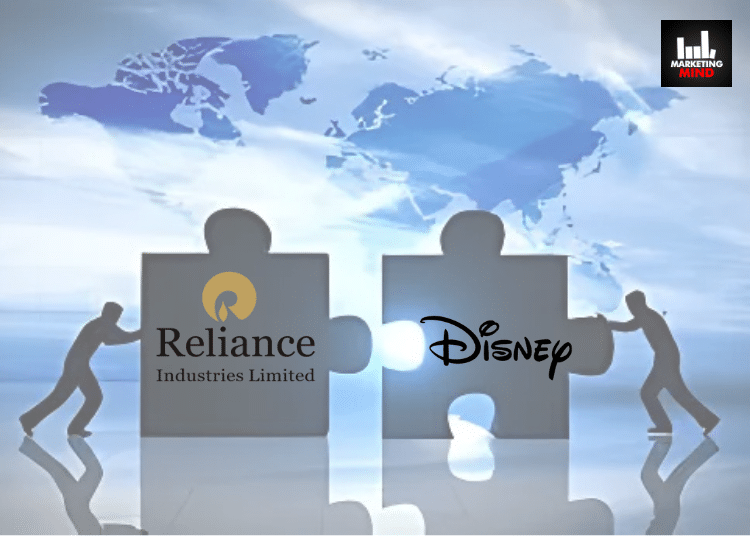Following approval from the NCLT Mumbai, the Competition Commission of India, and other regulatory authorities, Reliance Industries (RIL), Viacom18 Media, and The Walt Disney Company have announced the successful merger of Viacom18’s media and JioCinema businesses with Star India, marking the formation of one of India’s largest media and entertainment companies.
This marks the official launch of their joint venture, ‘JioStar’. The transaction values the JV at Rs 70,352 crore ($ 8.5 billion) on a post-money basis, excluding synergies. At the closing of the transactions noted above, the JV is controlled by RIL and owned 16.34% by RIL, 46.82% by Viacom18 and 36.84% by Disney.
Also read: Reliance & Disney Complete Transaction For $8.5 Billion Merger Deal
Industry leaders, in conversations with Marketing Mind, view this as a positive development, seeing it as an opportunity to invest more in high-quality content. This move is expected to foster the creation of exceptional content that resonates with Indian audiences while positioning India as a global leader in content creation. Additionally, the believe that the merger is set to significantly impact the entire M&E ecosystem, with the combined entity commanding a substantial market share.
However, some industry players argue that, from a legal perspective, the merger raises concerns about its potential impact on pricing structures and advertising contracts for both television and streaming platforms.
Ashish Bhasin, Founder The Bhasin Consulting Group, said that this is a highly positive development with the potential for significant impact. Firstly, with access to substantial resources in the scaled entity, there is an opportunity to invest more in high-quality content. This paves the way for creating exceptional content that not only resonates with Indian audiences but also positions India as a global leader in content creation.

“Historically, we have consumed content from Western and other Eastern countries, but given the immense talent in India, be it in filmmaking, storytelling, or production, there is no reason why India cannot dominate the global stage in content creation,” he said.
“In the next 5 to 10 years, Indian content has the potential to prevail internationally, moving beyond our reliance on shows and productions from countries like Spain, the USA, or Korea. This shift will not only elevate the quality of content for Indian viewers but also establish India as a premier provider of world-class content on the global map. This is a tremendous opportunity to showcase India’s creative capabilities and become a powerhouse in the global entertainment industry,” he added.
Furthermore, he went on to say that this also marks the beginning of an era of consolidation across the media and advertising industries.
“In advertising, for instance, we already see that around five major groups command 80% of the global market share, though the degree of consolidation varies by region. I believe a similar trend will soon emerge in broadcasting. While the Zee-Sony merger didn’t go through, it’s only a matter of time before we see more mergers and acquisitions in this space. This shift won’t be limited to television alone but will likely extend to print and digital as well, though digital is already fairly consolidated. Overall, consolidation seems to be the direction the industry is heading,” Bhasin added.
He explained that the third key point is the potential for creating upward pressure on advertising prices due to the emergence of a giant entity. However, advertising rates are ultimately governed by the principles of supply and demand, ensuring that the market eventually finds its balance. This natural equilibrium helps maintain a sense of stability despite initial fluctuations.
Also read: Here’s The Leadership Team Steering ‘JioStar’
Meanwhile, Bharath Gangadharan, Counsel, SKV Law Offices, emphasised that in August this year, the Competition Commission of India (CCI) granted conditional approval for the $8.5 billion merger between Viacom18-Star India and Reliance, with Reliance and its affiliates set to hold a 63% stake in the combined media assets, while Walt Disney will retain 36%.

“The public discourse around the merger was surrounded by natural concerns of a monopoly establishing itself – given the scale of the resultant entity. Known areas of concern include cricket broadcasting rights, with reports suggesting that the companies may divest certain channels to facilitate the merger’s approval after previous apprehensions expressed by the CCI. From a legal standpoint, the merger raises questions about its impact on pricing structures and advertising contracts for both television and streaming platforms,” he said.
Gangadharan explained that additionally, the costs associated with streaming services could be affected, and the conduct of the merger entity may be scrutinised under section 4 of the Competition Act if competitors allege an abuse of dominant market position. The CCI will likely engage a monitoring agency to ensure compliance with these voluntary commitments, allowing for market testing and verification of the proposed remedies.
This process will require close cooperation between the merging entities and the monitoring agency to manage advertiser relationships and any divestitures effectively.
“As for concerns about potential monopolistic dominance, the CCI remains committed to preventing monopolistic practices under India’s Competition Laws. While the merged entity may hold a significant market position in certain segments, the CCI’s oversight is expected to ensure that market competitiveness is preserved, addressing any tendencies toward monopoly formation,” he added.
In a recent conversation with Marketing Mind, Karan Taurani, SVP at Elara Capital highlighted that the merger of Viacom18 and Star India will have a big impact on the entire M&E ecosystem as the combined entity will command a huge market share. The merger will create a large media juggernaut with 108+ channels (Star India has 70+ TV channels in 8 languages whereas Viacom has 38 TV channels in 8 languages), two large OTT apps (JioCinema and Hotstar) and two film studios (one each of Reliance and Disney India).

“The consolidation between RIL and Disney on the India TV side could have a negative impact on other linear TV broadcasters, such as Sun TV, Zee, Sony, and others, as they may not be able to scale up on market share. The merged entity’s focus on maximising market share through increased investments in content, synergies, and enhanced marketing power poses challenges for individual broadcasters to compete and grow,” he said.
“With a large customer base across various genres, including regional genres and Urban GEC, the combined entity aims to dominate key markets, potentially leading to market share loss and challenges for other players, including the possibility of smaller channels shutting down,” he added.
Furthermore, he went on to say that the merger of JioCinema and Disney+ Hotstar poses a challenge for global OTT platforms, as India’s market values bundling and is price sensitive. The combined entity can offer a comprehensive package including web series, movies, sports, originals, and a global catalogue. This bundled premium plan, possibly in collaboration with Jio’s large subscriber base, may hinder the ability of global OTT platforms to raise Average Revenue Per User (ARPU).
















